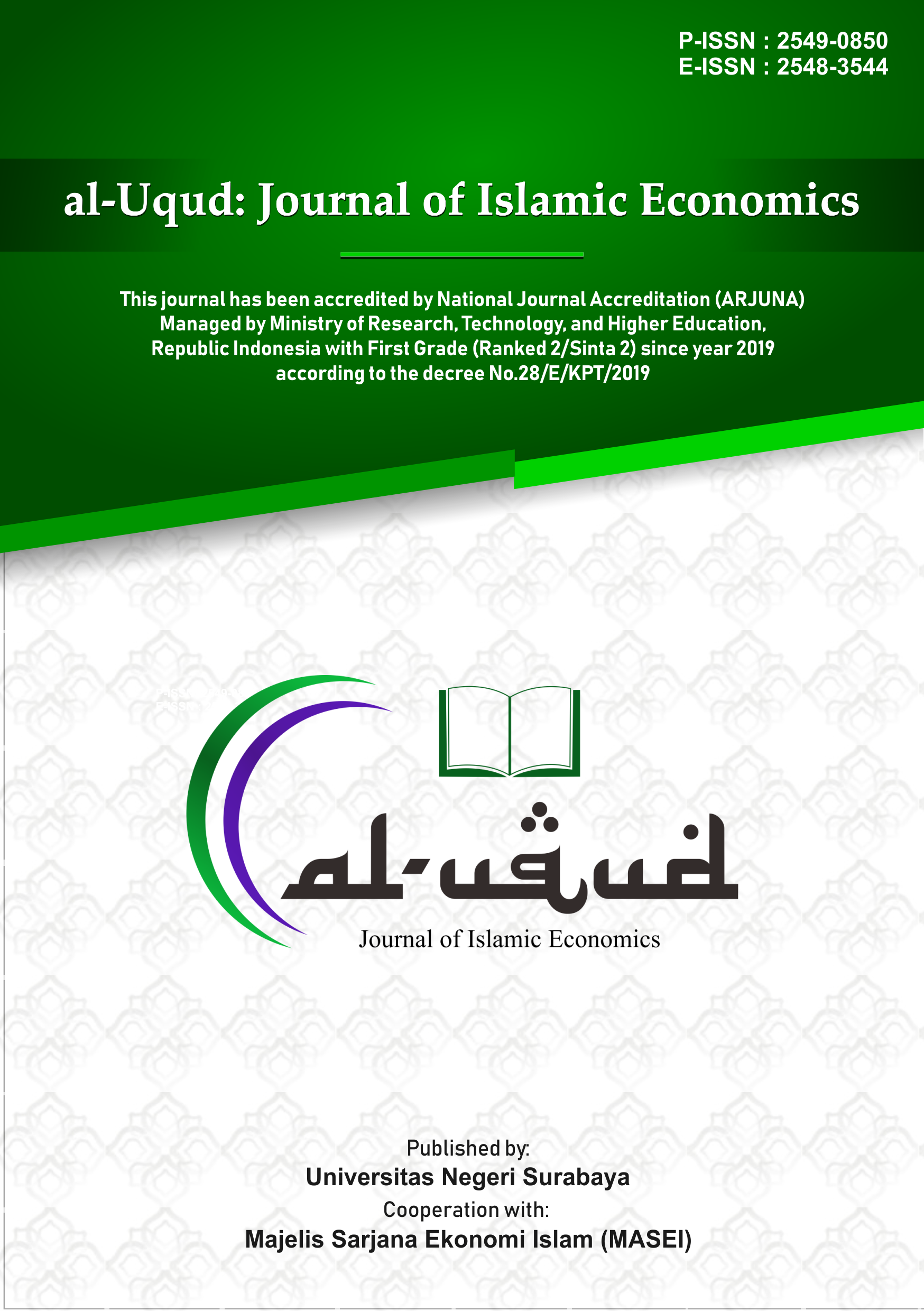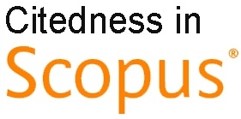Do Indonesian Islamic Microfinance Institutions Need Lender of the Last Resort?
DOI:
https://doi.org/10.26740/al-uqud.v4n2.p235-249Keywords:
Islamic Microfinance Institution, Islamic Cooperatives, Lender of the Last Resort, LiquidityAbstract
Liquidity risk is one of significant risk managed by financial intermediaries including Islamic Microfinance Institutions (IMFIs). The financial intermediaries accept short-term deposits and disburse these deposits in the form of long-term loans. This situation makes IMFI desperately need a lender of last resort (LOLR). Nevertheless, there has been no formal LOLR for Indonesian IMFIs. This study intends to construct the LOLR model for IMFI in Indonesia. This qualitative study applies a case study analysis. This study's subjects are IMFIs in East Java Province that was selected purposively with thirty managers as the key informants. Research findings show that the best model of LOLR is developing a secondary cooperative since the majority form of IMFIs in Indonesia are cooperative entities. With all members of a secondary cooperative deposit for reserve requirements, they can place excess liquidity in the secondary cooperative and ask for financial support.
References
Abdullah, R., & Ismail, A. G. (2014). Al-Tawhid about the economic order of microfinance institutions. Humanomics, 30(4), 325348. https://doi.org/10.1108/H-01-2014-0006
Adnan, M. A., &Ajija, S. R. (2015). The effectiveness of Baitul Maal wat Tamwil in reducing poverty The case of Indonesian Islamic Microfinance Institution Muhammad. Humanomics, 31(3), 354371. https://doi.org/10.1108/H-04-2014-0037
Arif, A., &Anees, A. N. (2012). Liquidity risk and performance of the banking system. Journal of Financial Regulation and Compliance, 20(2), 182195. https://doi.org/10.1108/13581981211218342
Asongu, S. A. (2013). Post-crisis bank liquidity risk management disclosure. Qualitative Research in Financial Markets, 5(1), 6584. https://doi.org/10.1108/17554171311308968
Bagehot, Walter, 1873. Lombard Street: A Description of the Money Market. London, H.S. King.
Bastidon, C., Gilles, P., &Huchet, N. (2008). The international lender of last resort and selective bail-out. Emerging Markets Review, 9(2), 144152. https://doi.org/10.1016/j.ememar.2008.02.004
Berhane, G., &Gardebroek, C. (2011). Does microfinance reduce rural poverty? Evidence-based on household panel data from northern Ethiopia. American Journal of Agricultural Economics, 93(1), 4355. https://doi.org/10.1093/ajae/aaq126
Bernstein, A., Hughson, E., &Weidenmier, M. D. (2010). Identifying the effects of a lender of last resort on financial markets: Lessons from the founding of the fed. Journal of Financial Economics, 98(1), 4053. https://doi.org/10.1016/j.jfineco.2010.04.001
Bordo, M. D. (2014). Rules for a lender of last resort: An historical perspective. Journal of Economic Dynamics and Control, 49, 126134. https://doi.org/10.1016/j.jedc.2014.09.023
Brigham, Eugene and Houston, Joel F. 2001. Dasar DasarManajemenKeuangan, Buku 2. Jakarta: SalembaEmpat.
Corsetti, G., Guimarães, B., & Roubini, N. (2006). International lending of last resort and moral hazard: A model of IMFs catalytic finance. Journal of Monetary Economics, 53(3), 441471. https://doi.org/10.1016/j.jmoneco.2005.03.008
Dahir, A. M., Mahat, F. B., & Ali, N. A. Bin. (2018). Funding liquidity risk and bank risk-taking in BRICS countries: An application of system GMM approach. International Journal of Emerging Markets, 13(1), 231248. https://doi.org/10.1108/IJoEM-03-2017-0086
Du, W., & Dong, G. (2013). Lecture Notes in Electrical Engineering: Preface. Lecture Notes in Electrical Engineering, 204 LNEE. https://doi.org/10.1007/978-1-4471-4802-9
Ensuring Financial Stability in Countries with Islamic Banking. (2017). In International Monetary Fund. Retrieved from http://www.imf.org/~/media/Files/Publications/PP/PP-Ensuring-Financial-Stability-in-Countries-with-Islamic-Banking.ashx
Fianto, B. A., Gan, C., Hu, B., &Roudaki, J. (2018). Equity financing and debt-based financing: Evidence from Islamic microfinance institutions in Indonesia. Pacific Basin Finance Journal, 52(September 2017), 163172. https://doi.org/10.1016/j.pacfin.2017.09.010
Fianto, B. A., Maulida, H., & Laila, N. (2019). Determining factors of non-performing financing in Islamic microfinance institutions. Heliyon, 5(8). https://doi.org/10.1016/j.heliyon.2019.e02301
Franck, R., &Krausz, M. (2007). Liquidity risk and bank portfolio allocation. International Review of Economics and Finance, 16(1), 6077. https://doi.org/10.1016/j.iref.2004.09.007
Garcia-de-Andoain, C., Heider, F., Hoerova, M., &Manganelli, S. (2016). Lending-of-last-resort is as lending-of-last-resort does: Central bank liquidity provision and interbank market functioning in the euro area. Journal of Financial Intermediation, 28, 3247. https://doi.org/10.1016/j.jfi.2016.01.003
Giannotti, C., Gibilaro, L., &Mattarocci, G. (2011). Liquidity risk exposure for specialised and unspecialised real estate banks: Evidence from the Italian market. Journal of Property Investment & Finance, 29(2), 98114. https://doi.org/10.1108/14635781111112756
Goodhart, C. A. E., & Huang, H. (2005). The lender of last resort. Journal of Banking and Finance, 29(5), 10591082. https://doi.org/10.1016/j.jbankfin.2003.11.003
Hadisumarto, W. B. M. C., & Ismail, A. G. B. (2010). Improving the effectiveness of Islamic micro-financing: Learning from BMT experience. Humanomics, 26(1), 6575. https://doi.org/10.1108/08288661011025002
Hassan, A., & Saleem, S. (2017). An Islamic microfinance business model in Bangladesh: Its role in alleviation of poverty and socio-economic well-being of women. Humanomics, 33(1), 1537. https://doi.org/10.1108/H-08-2016-0066
Hassan, M. K., Aliyu, S., Huda, M., & Rashid, M. (2019). A survey on Islamic Finance and accounting standards. Borsa Istanbul Review, 19, S1S13. https://doi.org/10.1016/j.bir.2019.07.006
Hendar&Kusnadi, 2005. EkonomiKoperasi (UntukPerguruan Tinggi) EdisiKedua, Lembaga PenerbitFakultasEkonomiUniversitas Indonesia. Jakarta
Holsti, Ole R. 1969. Content Analysis for the Social Science and Humanities.Reading, Massachusetts: Addison Westley Pub lishing.
Hubbard, G.R. (2002), Money, The Financial System, and the Economy. New Jersey: The Addison Wesley Series in Economics, Person Education Inc.
Lastra, R. M. (1999). Central banks as lenders of last resort: Lessons from the Asian contagion. Journal of Financial Regulation and Compliance, 7(3), 234242. https://doi.org/10.1108/eb025011
Lerrick, A., & Meltzer, A. H. (2003). Blueprint for an international lender of last resort. Journal of Monetary Economics, 50(September 2002), 289303.
Littlefield, E., Morduch, J., & Hashemi, S. (2003). Is Microfinance an Effective Strategy to Reach the Millennium Development Goals¯? In CGAP (Vol. 24). Retrieved from http://ifmr.ac.in/cmf/wp-content/uploads/2007/06/mf-mdgs-morduch.pdf
Matsuoka, T. (2012). Journal of Economic Dynamics & Control Imperfect interbank markets and the lender of last resort. Journal of Economic Dynamics and Control, 36(11), 16731687. https://doi.org/10.1016/j.jedc.2012.05.003
Mawardi, I., Sukmaningrum, P. S., Widiastuti, T., & Al Mustofa, M. U. (2019). Optimum financing portfolio of islamic microfinance institutions¯: Indonesia case. UtopÃa y Praxis Latinoamericana, 24 (EXTRA 5), 268274.
Mohammad, S. (2013). Liquidity Risk Management in Islamic Banks: A Survey. Afro Eurasian Studies, 1(2), 215230. Retrieved from http://www.afroeurasianstudies.net/dosyalar/site_resim/veri/1513272.pdf
Muttaqien. 2008. Aspek Legal Lembaga Keuangan Syariah Bank, LKM, Asuransi, dan Reasuransi. Yogyakarta: SafiriaInsania Press.
Naqvi, H. (2015). Banking crises and the lender of last resort: How crucial is the role of information? Journal of Banking and Finance, 54, 2029. https://doi.org/10.1016/j.jbankfin.2015.01.004
Okazaki, T. (2007). Micro-aspects of monetary policy: Lender of Last Resort and selection of banks in pre-war Japan. Explorations in Economic History, 44, 657679. https://doi.org/10.1016/j.eeh.2006.11.002
Ponce, J., &Rennert, M. (2015). Systemic banks and the lender of last resort. Journal of Banking and Finance, 50, 286297. https://doi.org/10.1016/j.jbankfin.2014.01.002
Rahman, R. A., & Dean, F. (2013). Challenges and solutions in Islamic microfinance. Humanomics, 29(4), 293306. https://doi.org/10.1108/H-06-2012-0013
Ratnovski, L. (2009). Bank liquidity regulation and the lender of last resort. Journal of Financial Intermediation, 18(4), 541558. https://doi.org/10.1016/j.jfi.2007.08.001
Riyanto, Bambang. 2001. Dasar-dasarPembelanjaan Perusahaan. BPFE, Yogyakarta.
Syamsudin, Lukman, 2004. ManajemenKeuangan. Jakarta: Penerbit Raja GrafindoPersada.
Tisdell, C., & Ahmad, S. (2018). Microfinance: economics and ethics. International Journal of Ethics and Systems, 34(3), 372392. https://doi.org/10.1108/IJOES-02-2018-0028
Wardiwiyono, S. (2012). Internal control system for Islamic micro financing: An exploratory study of Baitul Maal wat Tamwil in the City of Yogyakarta Indonesia. International Journal of Islamic and Middle Eastern Finance and Management, 5(4), 340352. https://doi.org/10.1108/17538391211282836
Downloads
Published
How to Cite
Issue
Section
License
CC BY 4.0 Abstract views: 1009
,
Abstract views: 1009
, PDF Downloads: 678
PDF Downloads: 678








